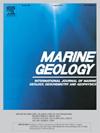风暴沉积物在泰国的Ko Phra Thong
IF 2.2
3区 地球科学
Q2 GEOSCIENCES, MULTIDISCIPLINARY
引用次数: 0
摘要
在过去的60年里,人们从世界各地的海岸线上描述了硅屑风暴沉积。这些风暴沉积物大多是由直接或间接登陆的风暴形成的,或者是切线绕过附近的海岸系统。在这些情况下,当风暴接近海岸线时,海岸上的水在冲破或超过海滩屏障之前堆积在海岸上。很少对风暴背风处海岸线上的风暴沉积物进行检查。我们描述了泰国西部Ko Phra Thong三个短沉积物岩心的小型风暴扇的沉积和地层变化。2007年5月,一个热带低气压穿过马来-泰国半岛,导致海水沿着海岸堆积,并破坏了Ko Phra Thong西海岸的小护堤,形成了这个扇形。充足的容纳空间使得后滩沉积物上沉积了细至中石英和富重矿物砂。基底接触层由沙滩上的土壤层组成,上面有丰富的木麻黄针叶。重矿物的水平层状是最低地层单元的特征,它被一个块状单元整合覆盖,而块状单元又被一个具有垂直和亚水平根结构的单元覆盖。在扇向陆地的末端,观察到微弱的向陆地倾斜的交叉层,表明终末林。由于Ko Phra Thong保留了过去海啸冲积砂沉积物的完善历史,因此该海岸上风暴冲积扇的存在使推断的冲积事件历史变得复杂。当古海岸线靠近峡谷时,这种复杂性尤为重要,在那里,较小的、能量较低的事件,如风暴,可以覆盖古堤岸并沉积沙质单元。这很可能发生在2500到2000年前,当时薄而无结构的沙质沉积物被安置在古海岸线附近。本文章由计算机程序翻译,如有差异,请以英文原文为准。
Storm sediment deposit from Ko Phra Thong, Thailand
Siliciclastic storm deposits have been described from coastlines around the world over the last six decades. Most of these storm deposits are formed from storms directly or obliquely making landfall, or tangentially bypassing nearby coastal systems. In these instances, coastal water piles up on the coast as the storm approaches the coastline before breaching or overtopping the beach barrier. Seldom have storm deposits been examined from coastlines on the lee of the storm. We describe the sedimentary and stratigraphical variation of a small storm fan from three short sediment cores from Ko Phra Thong, western Thailand. The fan was formed after a tropical depression crossed the Malay-Thai peninsula in May 2007, resulting in water piling up along the coast and breaching of the small berm on the western coastline of Ko Phra Thong. Sufficient accommodation space resulted in fine to medium quartz and heavy-mineral rich sands to be deposited upon the back beach sediments. The basal contact consists of a soil horizon above beach sands with an abundance of Casuarina equisetifolia needles. Horizontal laminations of heavy minerals characterise the lowest stratigraphic unit, conformably overlain by a massive unit which is in turn overlain by a unit with vertical and sub-horizontal root structures. At the landward extremity of the fan, faint landward dipping cross beds are observed, indicative of terminal foresets. As Ko Phra Thong preserves a well-established history of past tsunami sand washover deposits, the presence of a storm overwash fan along this coast complicates the inferred overwash event history. This complication is particularly pertinent when the palaeo-shoreline was closer to the swales where smaller, lower energy events, such as storms, can overtop the palaeo-berm and deposit sandy units. This most likely occurred between 2500 and 2000 years ago when thin, structureless sandy deposits were emplaced near the palaeo-shoreline.
求助全文
通过发布文献求助,成功后即可免费获取论文全文。
去求助
来源期刊

Marine Geology
地学-地球科学综合
CiteScore
6.10
自引率
6.90%
发文量
175
审稿时长
21.9 weeks
期刊介绍:
Marine Geology is the premier international journal on marine geological processes in the broadest sense. We seek papers that are comprehensive, interdisciplinary and synthetic that will be lasting contributions to the field. Although most papers are based on regional studies, they must demonstrate new findings of international significance. We accept papers on subjects as diverse as seafloor hydrothermal systems, beach dynamics, early diagenesis, microbiological studies in sediments, palaeoclimate studies and geophysical studies of the seabed. We encourage papers that address emerging new fields, for example the influence of anthropogenic processes on coastal/marine geology and coastal/marine geoarchaeology. We insist that the papers are concerned with the marine realm and that they deal with geology: with rocks, sediments, and physical and chemical processes affecting them. Papers should address scientific hypotheses: highly descriptive data compilations or papers that deal only with marine management and risk assessment should be submitted to other journals. Papers on laboratory or modelling studies must demonstrate direct relevance to marine processes or deposits. The primary criteria for acceptance of papers is that the science is of high quality, novel, significant, and of broad international interest.
 求助内容:
求助内容: 应助结果提醒方式:
应助结果提醒方式:


